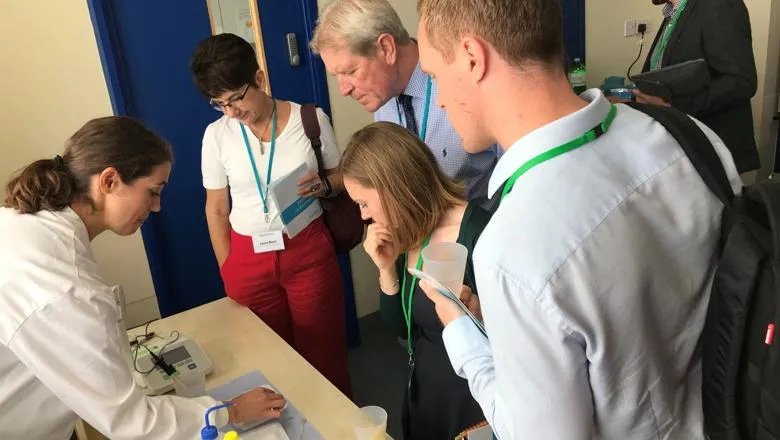The faculty hosted an industry meeting to support routine screening of erosive tooth wear at every dental examination in the UK on Monday 22nd of July. The event marked 6 months’ work between King’s College London, GSK, the British society of Dental Hygienists and Therapists, FGDP, Dental Protection and the Erosive tooth Wear Foundation. The working group was established in December 2018 and came to conclusions that all UK dentists should routinely screen for erosive tooth wear. The examination guide was designed at King’s to mirror the gum disease examination currently in practise in clinics. The clear message was that all dentists should screen for erosive tooth wear and then inform the patient about their risks, and where appropriate give preventative advice.
Professor David Bartlett, Head of Prosthodontics at the Faculty of Dentistry, Oral & Craniofacial Sciences
22 July 2019
Campaign to drive routine screening for Erosive Tooth Wear launched by leading UK dental bodies, including King's College London
Academics at King’s College London’s Faculty of Dentistry, Oral & Craniofacial Sciences together with leaders of the Erosive Tooth Wear Foundation and GSK launched a joint campaign to drive awareness of Erosive Tooth Wear.

- Erosive Tooth Wear (ETW) is the third most commonly observed oral condition, affecting up to 30% of European adults[1]
- Despite the rise of snacking culture and other modern lifestyle factors leading to increase in ETW, it is currently not routinely screened, or monitored, as part of the standard dental examination
- Leaders from key UK Dental Bodies have joined forces to launch a new campaign to drive screening for ETW as part of the standard dental examination
Academics at King’s College London’s Faculty of Dentistry, Oral & Craniofacial Sciences together with leaders of the Erosive Tooth Wear Foundation and GSK launched a joint campaign to drive awareness of Erosive Tooth Wear.
Despite being the third most commonly observed oral condition, affecting up to 30% of European adults [1] and not requiring a drill to fix, UK research shows that ETW is currently not routinely screened, or monitored, as part of the standard dental examination [2].
Erosive Tooth Wear occurs when the outer layer (enamel) of the tooth slowly dissolves. This can lead to changes in the shape or appearance of teeth, and they may become sensitive when eating or drinking cold food and drink. At its worst, the tooth structure can gradually wear away.
The group of leading UK dental bodies set on tackling this issue includes the Faculty of General Dental Practice (UK), British Society of Dental Hygienists and Therapists, Dental Protection Society, GSK, the makers of Pronamel and clinical academics from King’s College London’s Faculty of Dentistry, Oral & Craniofacial Sciences.
These leading experts are calling on the dental profession to use the basic erosive wear examination (BEWE) alongside the basic gum disease examination as part of every oral assessment to prompt early identification and prevention. As it follows the same approach as the gum disease examination, an erosive tooth wear check can be conducted at the same time, therefore requiring little additional clinical time.
Although the condition may have a slow rate of progression, the impact on aesthetics and function, as well as the financial implication of restoration, can be significant. According to a study by O’Toole et al., costs could be up to £31,000 for private treatment and the average treatment took 21 months[3].
Reports show that the rise in snacking culture on fresh fruit and fruit juices increased the risk of developing ETW by 12 times, especially when they are consumed outside of meals.
Professor David Bartlett, Head of Prosthodontics and Graduate Training at King’s College London’s Faculty of Dentistry, Oral & Craniofacial Sciences comments: “ETW is the third most common dental condition and prevalence is increasing, but it’s not routinely identified. The basic erosive tooth wear examination was designed specifically for use in general dental practice, it is a simple tool to use and will screen for the condition and prompt preventative discussions with patients.”
Dr Saoirse O’Toole, Clinical Lecturer in Prosthodontics at King’s College London’s Faculty of Dentistry, Oral & Craniofacial Sciences comments: “Often when patients are referred to the hospital for treatment, it is because early signs may not have been identified and changes to behaviour have not been discussed with patients. Simple advice, such as limiting the number of acidic drinks you have and switching when you have them to mealtimes may make a real difference in reducing patient risk.”
Comprehensive educational resources for both the clinician and patient to support this campaign are available via the Erosive Tooth Wear Foundation website https://www.erosivetoothwear.com.
[1] Bartlett et al. Monitoring erosive tooth wear: BEWE, a simple tool to protect patients and the profession. BDJ 2019; 226(12): 930-932
[2] O’Toole S, Khan M, Patel A, Patel NJ, Shah N, Bartlett D, et al. Tooth wear risk assessment and care-planning in general dental practice. Br Dent J 2018;224. doi:10.1038/sj.bdj.2018.171.
[3] O’Toole S et al. The treatment need and associated cost of erosive tooth wear rehabilitation – a service evaluation within an NHS dental hospital. BDJ 2018; 224: 957-961
[4] O’Toole et al. Journal of Dentistry. 2017; 56: 99-104



